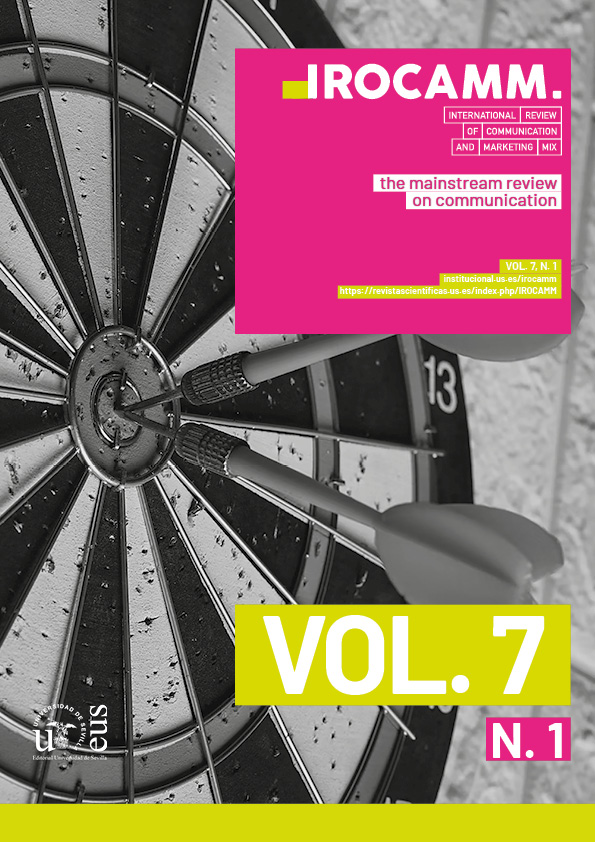Abstract
Although the first Internet experiences in Spain are related to e-mail and the use of some functionalities, such as file exchange or access to institutional directories, the popularization of the Internet coincides in time with the arrival of the Web in the second half of the last century. The media professionals and technology companies that lived through this historical moment witnessed the transformation of communication and of the citizens’ model for relating to their environment and the world as a whole. This paper analyzes the arrival of the Internet in Spain and its evolution until it became a marketable product, turning it into a global and omnipresent means of communication, as it is today.
References
de Alzaga, P. (January 13, 1999). British Telecom compra uno de los mayores proveedores de Internet españoles. El Mundo. https://bit.ly/3HtEaiG
Aranda, V. T. (2004). Historia y evolución de internet. Autores científico-técnicos y académicos, 33(1), 22–32. https://bit.ly/2JlmoUa
Bates, B. J., & Lansing, K. P. (1993). The New World of democratic telecommunications: FIDONET as an example of the new horizontal information networks. Southwestern Mass Communication Journal, 8, 1–2. https://bit.ly/3HrmOTA
Berners-Lee, T. (2000). Tejiendo la Red. Siglo XXI.
Bolaños, A. (February 14, 1999). Dos sevillanos que triunfan en la Red. El País. https://bit.ly/3O3VNIr
Bush, R. (1993). FidoNet: Technology, tools, and history. Communications of the ACM, 36(8), 31–35. https://bit.ly/3mRDPwR https://doi.org/10.1145/163381.163383
Caballero, L. (September 8, 2016). El otro Goya que hizo historia: así nació el primer proveedor de internet en España. El Diario.es. https://bit.ly/3aTb28h
Carpintier, R. (2000). Servicom y World Online; vidas divergentes. Baquía. https://bit.ly/3Qpky3A
Casero-Ripollés, A. (2015). Estrategias y prácticas comunicativas del activismo político en las redes sociales en España. Historia y Comunicación Social, 20(2), 533–548. https://doi.org/10.5209/rev_HICS.2015.v20.n2.51399
Codina, L. (2020). Cómo llevar a cabo revisiones bibliográficas tradicionales o sistematizadas en trabajos de final de máster y tesis doctorales. Universitat Pompeu Fabra, Departamento de Comunicación, Máster Universitario en Investigación en Comunicación Social (MUCS). https://bit.ly/3Ga8Apm
Díaz Noci, J. (2005). Historia de los cibermedios en España. In R. Salaverría (Coord.), Cibermedios (pp. 21–38). Comunicación Social.
El Hamdouni, Y. (2013). Internet y la primavera árabe. Hacia una nueva percepción del ciberespacio. Peace and Security - Paix et Sécurité Internationales (Euromediterranean Journal of International Law and International Relations), (1), 167–173. https://doi.org/10.25267/Paix_secur_int.2013.i1.12
Folgueiras Bertomeu, P. (2016). La entrevista. Universitat de Barcelona.
García-Sicilia, F. (1995). Microsoft lanza un controvertido servicio online. Information world en español (IWE), 4(31), 16–17.
Hahn, H. (1994). Internet: Manual de referencia. McGraw-Hill.
Lacerda Nobre, T. L., Umbelino, C. X., & Alves, L. O. (2021). La influencia de la tecnología de la información en las relaciones amorosas en la modernidad de la red. IROCAMM. International Review Of Communication And Marketing Mix, 1(4), 89–98. https://doi.org/10.12795/IROCAMM.2021.v01.i04.08
Leiner, B. M., Cerf, V. G., Clark, D. D., Kahn, R. E., Kleinrock, L., Lynch, D. C., & Wolff, S. (1997). The Past and Future History of the Internet. Communications of the ACM, 40(2), 102–108. http://bit.ly/3tHcgtC https://doi.org/10.1145/253671.253741
Loane, S., McNaughton, R. B., & Bell, J. (2004). The internationalization of Internet-enabled entrepreneurial firms: Evidence from Europe and North America. Canadian Journal of Administrative Sciences/Revue Canadienne des Sciences de l’Administration, 21(1), 79–96. https://doi.org/10.1111/j.1936-4490.2004.tb00324.x
Martínez Canizales, G. A. (2020). De las redes a las calles: Las redes sociales y su efecto en el caso de la Primavera Árabe. Horizonte Histórico - Revista Semestral de los Estudiantes de la Licenciatura en Historia de la UAA, (21), 18–29. https://doi.org/10.33064/hh.vi21.3206
Molist, M. (May 24, 2014). Aunque parezca mentira, siguen existiendo BBS. El Mundo. https://bit.ly/3xVihFU
Moreno Espinosa, P., Román-San-Miguel, A., & Olivares-García, F. J. (2021). Tim Berners-Lee frente a los dueños de Internet en la era de la sobre información. Estudios sobre el Mensaje Periodístico, 27(1), 365–374. https://doi.org/10.5209/esmp.71328
Norris, P. (2015). Movilización política y redes sociales. El ejemplo de la Primavera Árabe. Infoamérica: Iberoamerican. Communication Review, (9), 17–36. bit.ly/40Gq9GN
Norris, P. (2000). The Internet in Europe: A new north-south divide? The Harvard International Journal of Press/Politics, 5(1), 1–12. https://doi.org/10.1177/1081180X00005001001
Olivares-García, F. J. (2002). Producción informativa en internet: Portales y medios de comunicación independientes [Tesis de doctorado no publicada]. Universidad de Sevilla.
Papí-Gálvez, N. (2020). A falta de un clic. Hacia una propuesta de modelo afectivo en planificación de medios. IROCAMM. International Review Of Communication And Marketing Mix, 2(3), 7–21. https://doi.org/10.12795/IROCAMM.2020.v02.i03.01
Pedreira, J. (September 4, 2015). 20 años de la presentación de Infovía. Microsiervos. http://bit.ly/3tDMGpi
Peiró, K. (1996). El fenómeno internet en España: Ayer, hoy y mañana. Web, 4. https://bit.ly/39q3lGq
Pérez-Seijo, S., Gutiérrez Caneda, B., & López García, X. (2020). Periodismo digital y alta tecnología: De la consolidación a los renovados desafíos. Index. comunicación: Revista científica en el ámbito de la Comunicación Aplicada, 10(3), 129–151. https://doi.org/10.33732/ixc/10/03Period
Pérez, A. (October 29, 1998). Proveedores de Internet: ¿víctimas o culpables? El Mundo. https://bit.ly/39COl82
Ramírez, M. (2022). El Periódico. Debate.
Sobieszczanski, M. (2011). Paul Baran (1926-2011) Pionnier des réseaux distribués. Hermès, La Revue-Cognition, communication, politique, (61), 221–225. https://bit.ly/3aM8FUK
Soto, J., Pérez, J., & Feijóo, C. (2003). Veinticinco años de sociedad de la información en España. Evolución tecnológica, globalización y políticas públicas. Economía Industrial, (6), 349–350. https://bit.ly/3JU0jZn
Sterling, B. (1993). A Short History of the Internet. Magazine of Fantasy and Science Fiction. https://bit.ly/3zWwt2a
Taguenca Belmonte, J. A., & Vega Budar, M. R. (2012). Técnicas de investigación social. La entrevista abierta y semidirectiva. Revista de investigación en ciencias sociales y humanidades, Nueva Época, 1(1), 58-94. https://bit.ly/3m3Ckfx
The World Bank. (March 28, 2023). Individuals using the Internet (% of population) - Spain. https://bit.ly/3Tt0gtZ
Timmers, P. (1998). Business models for electronic markets. Electronic Markets, 8(2), 3–8. https://doi.org/10.1080/10196789800000016
Trejo Delarbre, R. (1996). La nueva alfombra mágica: usos y mitos de internet, la red de redes. Diana.
Vargas-Jiménez, I. (2012). La entrevista en la investigación cualitativa: Nuevas tendencias y retos. Revista Electrónica Calidad en la Educación Superior, 3(1), 119–139. https://doi.org/10.22458/caes.v3i1.436
Vaughan-Nichols, S. (2015). Before the Web: Online Services of Yesteryear. ZDnet. https://zd.net/3QxVQy0

This work is licensed under a Creative Commons Attribution-NonCommercial-ShareAlike 4.0 International License.
Copyright (c) 2023 IROCAMM - International Review Of Communication And Marketing Mix

